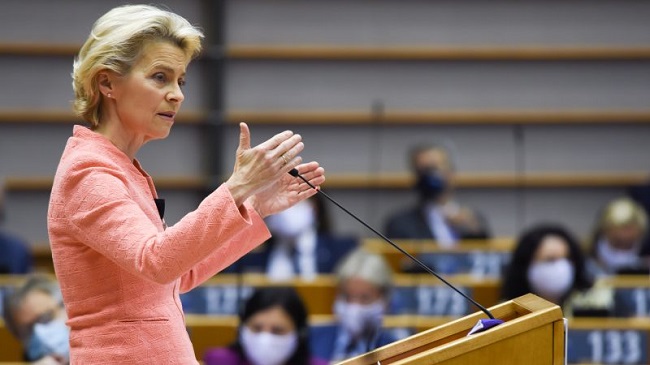European Commission President, Ursula von der Leyen, announced plans on Wednesday, September 16, 2020 to target a 55% cut in greenhouse gas emissions by 2030 as part of a broader European Green Deal programme aimed at reaching “climate neutrality” by mid-century.

“For us, the 2030 target is ambitious, it’s achievable and it is beneficial for Europe,” von der Leyen said as she unveiled the EU’s new climate proposals before the European Parliament in her first State of the Union address since she became Commission President in 2019.
“We can do it!” she said, borrowing a famous phrase used by German Chancellor Angela Merkel during the height of the 2015 migration crisis.
“Our impact assessment clearly shows that our economy and industry can manage this,” she continued, saying EU countries have already managed to reduce emissions by 25% since 1990 while growing the economy by more than 60%.
The difference today, she said, is that Europe now has the technology, the expertise and the financial firepower necessary to make it happen, with a €1.8 trillion EU budget and recovery fund that was agreed by EU leaders in July for the years 2021-2027.
“We are world leaders in green finance, and we are the largest issuer of green bonds worldwide,” von der Leyen pointed out, announcing that 30% of the EU’s €750 billion recovery fund will be raised through green bonds.
“We have it all. Now it’s our responsibility to implement it and to make it happen,” she added, telling Parliamentarians: “This is our mission”.
The announcement on the EU’s new 2030 climate target was widely expected after reports emerged last week that the Commission President would announce them in her speech.
Ottmar Edenhofer, Director of the Potsdam Institute for Climate Impact Research (PIK, member of the Leibniz Association), commented on the proposal.
He said: “If we want to rapidly stabilise our climate, reducing greenhouse gas emissions to a greater extent is absolutely the right approach taken by the EU. But formulating ambitious goals is not enough – we need concrete measures now. First and foremost, this means the introduction of a minimum price on CO2 in the EU emissions trading system (ETS) to provide incentives for investment in CO2-free technologies – as economic research shows very clearly.
“In addition, other sectors should be included in emissions trading, such as heating and road transport. Also, in the medium term, the ETS should be linked to existing pricing schemes, for example in China or California. Nobody in the world has the necessary strength for this – except Europe. But we have to actually do it.
“The EU can be an international pioneer when it comes to climate change mitigation and encouraging other countries to bring their policies into line with the goals of the Paris Climate Change Agreement which has been agreed by almost all governments. The EU can do so for example by granting cheap loans to countries that in return withdraw from coal or introduce effective CO2 pricing systems; here too, scientific concepts are available.
“The ‘EU Green Deal’ is a strong initiative. But now is the time for concrete implementation so that we can protect people from the economic and health risks of climate change in a timely and socially just manner.”
